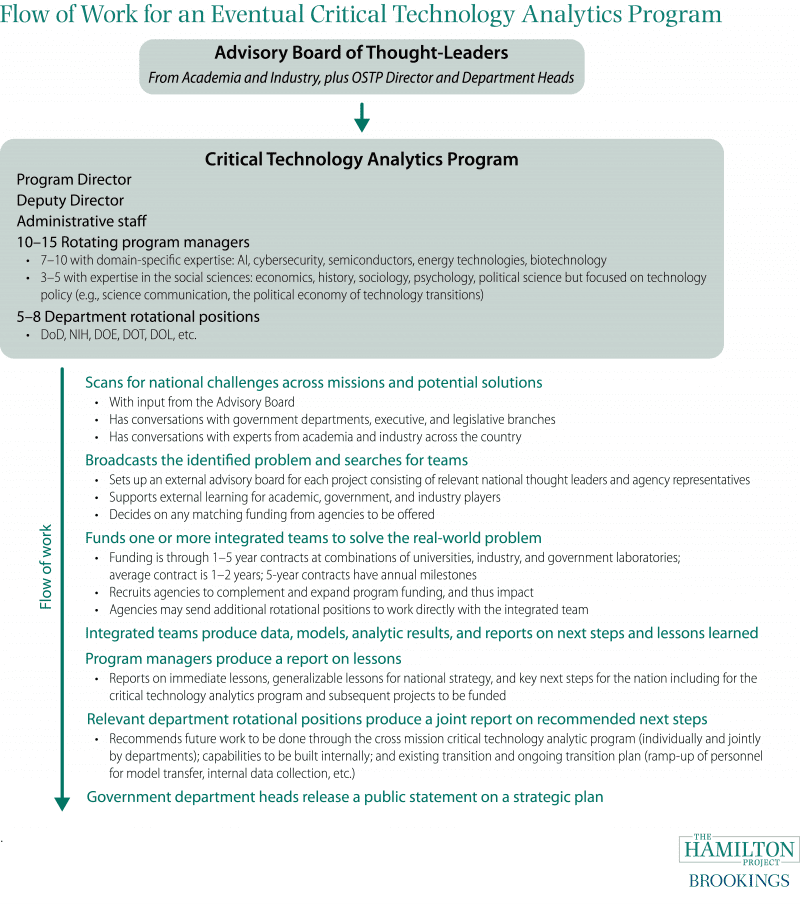In a Hamilton Project proposal, author Erica R.H. Fuchs of Carnegie Mellon University and the National Bureau of Economic Research proposes the creation of a national capability for cross-mission critical technology analytics to build the intellectual foundations, data, and analytics needed to inform national technology strategy. Specifically, Fuchs’s proposal would:
- Create a critical technology analytics (CTA) federal program focused on informing technology policy decisions that are cross-mission in nature—for example, spanning national security, economic prosperity, and social welfare—and thus beyond the purview of any one federal agency or private firm; and,
- Ensure the program would have a highly flexible, distributed structure capable of rapidly mobilizing experts from academia, industry, government laboratories, and government departments.
The Challenge
Existing federal agencies relevant to the science and technology enterprise are appropriately focused on their missions, but the U.S. lacks the intellectual foundations, data infrastructure, and analytics to identify opportunities where the value of investment across missions (e.g., national security, economic prosperity, social well-being) is greater than the sum of its parts.
The U.S. government lacks systematic mechanisms to assess the nation’s strengths, weaknesses, and opportunities in technology and to assess the long chain of suppliers involved in producing products critical to national missions.
Two examples where modern data and analytics—leveraging star interdisciplinary talent from across the nation—and a cross-mission approach could transform outcomes include 1) the difficulties the federal government had in facilitating the production and distribution of personal protective equipment in spring 2020, and 2) the lack of clarity about the causes and solutions to the semiconductor shortage. Going forward, the scale-up of electric vehicles promises similar challenges.
The U.S. government lacks systematic mechanisms to assess the nation’s strengths, weaknesses, and opportunities in technology
The Proposal
The critical technology analytics (CTA) would identify 1) how emerging technologies and institutional innovations could potentially transform timely situational awareness of U.S. and global technology capabilities, 2) opportunities for innovation to transform U.S. domestic and international challenges, and 3) win-win opportunities across national missions. The program would be strategic and forward-looking, conducting work on a timeline of months and years rather than days and weeks, and would seek to generalize lessons from individual cases to inform the data and analytics capabilities that the government needs to build to support cross-mission critical technology policy.
To build the intellectual foundations and to determine best practices, a pilot program focused on bringing the analytic power and talent from across academia and industry to critical technology policy problems would precede the full CTA program. This pilot program would start with a smaller annual budget, perhaps $10 million annually, co-funded by public and private funds.
Once established, the CTA program would have an annual budget appropriated by Congress of roughly $20 million with another roughly $30 million from other federal entities funding CTA program analyses. Those analyses would be completed by a nationally distributed network of experts drawn from academia and industry as well as dedicated employees who serve three- to five-year rotational terms as program managers and translational staff. Teams engaged in the network would be integrated across disciplines, and network membership would shift as needs arise.
The program would interact extensively with other agencies. This would be formalized through a program advisory board with membership from government agencies as well as academia and industry, in addition to the rotating members from government who would be dedicated to specific projects. Areas of study would be chosen by the program director, with significant input from the advisory board.
The CTA program would produce reports with data and analytics on the value of different technology investment or policy decisions under different scenarios and for different government missions, potential win-win pathways across missions, and generalizable lessons. Federal agencies represented on the advisory board would be required to publicly comment on how they would act upon the program’s recommendations.
What the CTA Program Would Not Do
Because the program must stay focused on building the intellectual foundations, data, and analytic tools to inform U.S. investment across missions in technologies critical to security, prosperity, and social well-being, it would not:
- Solve the short-term problems of the day or week;
- Become the permanent place to do work (e.g., taking full responsibility for monitoring technology and supply chains); or,
- Build long-term data infrastructure (instead of providing guidance on how other agencies should build such infrastructure).




